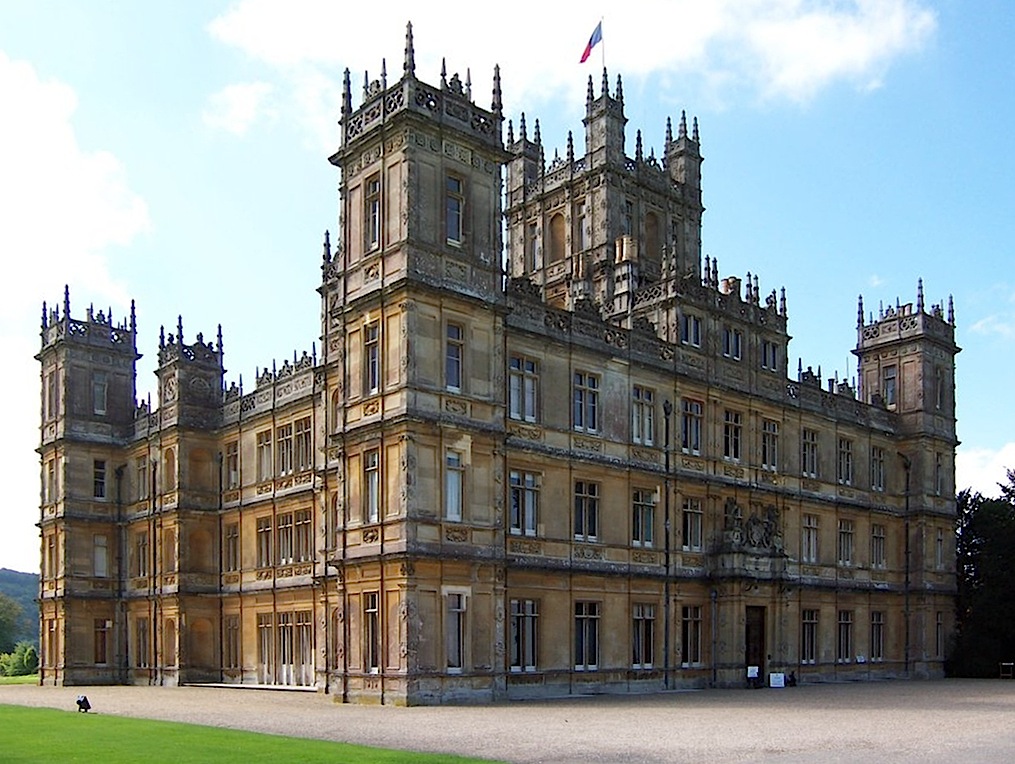Castles and country houses. For one it is merely an architectural proof of a bygone aristocratic stronghold, for the other an embodiment that fairy tales still exist. Not only the well-known Netflix series “Downton Abbey” contributed to my fascination for this sort of high architecture, but also the annual holiday trips to an old château in Normandy were reasons for a growing passion for elitist estates. But what makes this form of heritage so intriguing and at the same time debatable? Is it the longing for the unattainable, the mystical unknown, something that we ourselves will never obtain, that attracts us to estates and castles? Is it the intrinsic value of the place itself? I wonder what are the possible of the reasons for this admiration of this kind of heritage and to what extent it is accessible for everyone to participate with it.
 Highclere Castle, Hampshire, England. Image credit: JB + UK_Planet via Wikipedia.
Highclere Castle, Hampshire, England. Image credit: JB + UK_Planet via Wikipedia.
‘Nothing succeeds as excess’
The Heritage Auction blog, an American platform related to Heritage Auctions, explains, using the Downton Abbey castle of the eponymous series (in real life known as Highclere Castle) as an example, where our fascination for such series and buildings comes from. (Not only Americans, since the Netflix-series received multiple Emmy awards and one Golden Globe for Best Miniseries). According to the Heritage Auction Blog, this fascination ultimately comes from the location itself with its original interior. The grotesque castle with all the authentic wealth and luxury was built to impress former visitors of the late 18th century and current viewers of the series. The blog then uses this explanation to make a smart link between their own auction offer and the fact that such aristocratic treasures are nowadays no longer as unattainable as the time in which they were manufactured. However, a relief is expressed about the perishing of social class differences that existed at that time. The writer of the blog, Holly Culbreath, states: “Happily, we were not born into, nor can living memory recall, a fixed class system of pointers and schleppers.” The Heritage Auction blog tends to say that despite the fact that cultural built heritage and other forms of aristocratic objects are related to a form of social exclusion, nowadays such treasures are accessible for everyone.
Are you in or out?
It is a fact that nowadays living the ‘high life’ is not as unattainable as is used to be. The ‘he who is born for a dime, will never be worth a quarter’ era is definitely over. However, it is still questionable whether heritage is free of social classes nowadays. According to the article ‘The Conservation of English Cultural Built Heritage: A Force for Social Inclusion?’ written by John Pendlebury, Tim Townshend, and Rose Gilro, there is a strong urge in the national government of the UK to put social inclusion on the agenda. Heritage could play a progressive role in this matter. The article points out that since the 1970’s, there have been strategic varieties in finding justifiable reasons to preserve heritage. Various valuable and profitable marks have been put on cultural built heritage sites in two different ways. On the one hand, cultural built heritage places can be seen as important historic sites where one can engage with the past, on the other hand, they can be seen as projects which can stimulate economic and social regeneration by conservation of the heritage. The article concludes that both different ways, the historic view and the regeneration view, can’t provide a watertight guarantee for stimulating social inclusion and to lock out social exclusion. Despite the fact that there is a change in the discourse in heritage, their presupposed values, the capability for self-reflection and in the extent to which there is physical participation in heritage, these developments do not provide assurance for a final, perfect balance in social participation in cultural built heritage.
Keeping it real
Keeping the aforementioned article in mind, I think we should question whether the heritage world should play a role in the game of social in- or exclusion of certain groups. The big question that pops into my head, in this case, is: is everyone ever satisfied at the same time? This is a utopian and at the same time unrealistic thought. No matter how broad and social you want to make heritage, there is always automatically a part you omit. There is no objective form of heritage, a way in which each party is satisfied. So, what now? Should we just throw in the towel? I think that this awareness of the fact that heritage does not tell a truthful history, but a possible version of it already helps to bring different groups of people closer together. What we absolutely must not do is to erase parts of this history, to forget the painful and dark moments of this history. We can’t change history, we can’t go back in time. But we can open ourselves to other versions of this history. And if we can do this, then 45 minutes daydreaming during a Downton Abbey episode is not a crime and everybody will be welcome to sit with us.